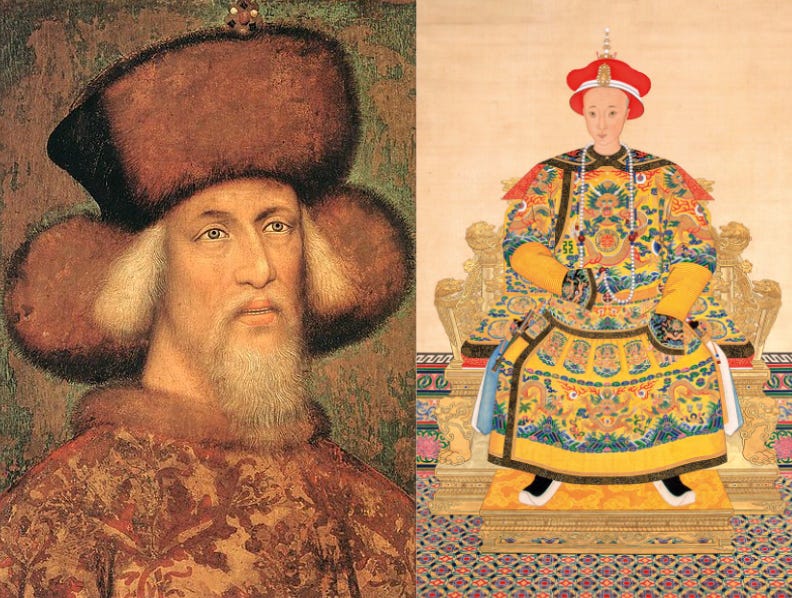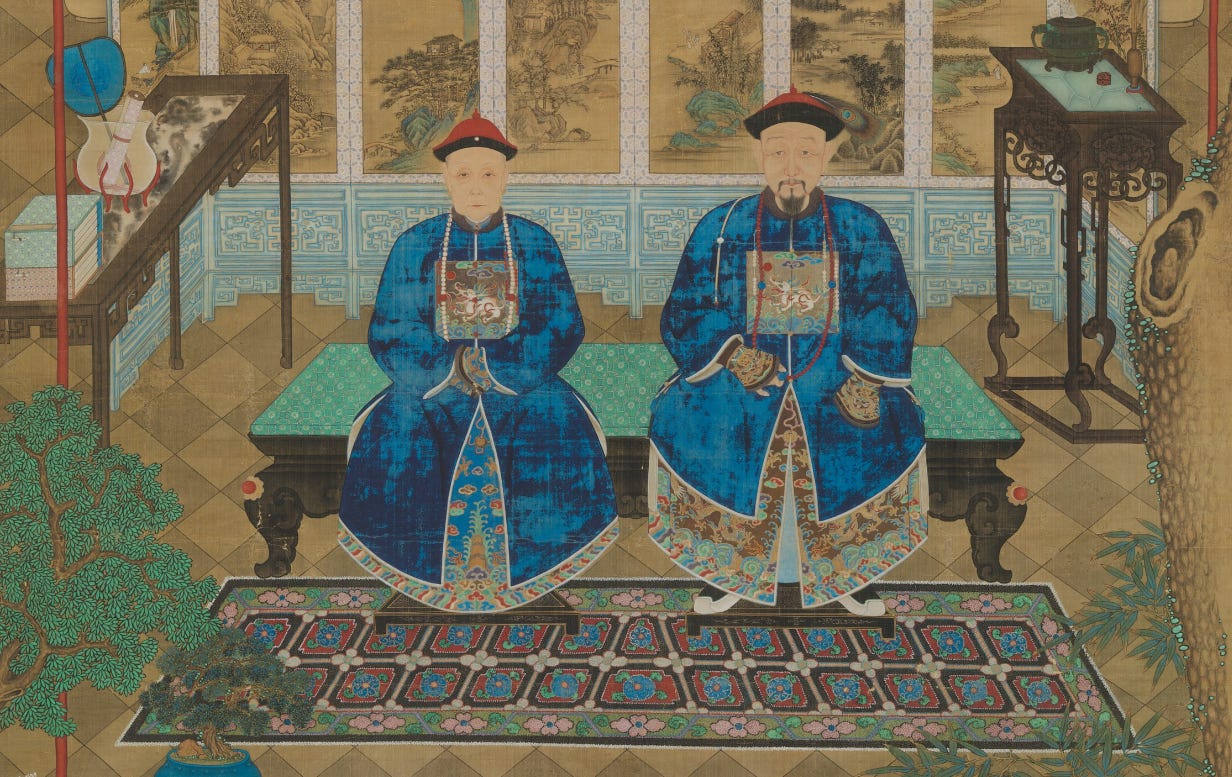Chinese Artistic Stagnation and the E. Asian Marriage Pattern:
(The East Asian Question Part 2)
Earlier in this series we looked at how US born East Asian female fertility is exactly the same as it would be had they never left East Asia and I argued that it reflected a long-term consequence of the East Asian Marriage Pattern. In this piece, we’ll look at two of it’s other consequences; stagnation in painting and music. Later we’ll look it’s consequences for athleticism, scientific innovation, the structure and (in)efficiency of commercial activity.
All throughout nature males compete for female attention by differentiating themselves from other males in feats of individual achievement. Human Males are no different and when left to their instincts - Men seduce women by outperforming other men in creative individualistic pursuits like music and painting, as-well as through displays of displays of individual vigor in athletic feats.
What happens when civilizations mobilize to eliminate all female choice in the question of who they reproduce with? You may get high IQ clerks, but in no society has any normal woman uttered the phrase:
“My parents wanted me to marry an artist but I hoped to marry a clerk.”
We can thereby expect a society that eliminates female choice in marriage to see a degradation and perhaps even the near-extinction of it’s creative potential. We can track and measure this phenomenon clearly in at least one society where it occurred - China.
Chinese vs European Painting
Here are court portraits of Three Royals; Sigismund - The Holy Roman Emperor (Left), Emperor Tongzhi center, and King Richard II. The years each portrait was painted are included with each image.
Note: I included King Richard II here to provide an example with as similar a style as Tongzhi and since no official portrait style picture exists of Sigismund’s predecessor.
Note 2: Always remember to consider relative population in these types of comparisons. The population of China was 430 Million in 1850, compared to the European population of 83 Million in 1450.
Fascinatingly (in a horrifying way), the Chinese portrait while including more decorative elements is no more lifelike than the portrait of Emperor Renzong (1010 - 1063).
This isn’t, or at least shouldn’t be an intellectual capability issue. Chinese landscape and nature painting for example reaches greater heights earlier than it’s European counterparts (Both of these pieces are no older than the 1300s). But it’s golden age then ends, and later traditional Chinese paintings while occasionally (perhaps) matching, never exceed these genuinely wonderful pieces in quality.
See full painting (One thousand Li of rivers and mountains by Wang Ximeng)
I would insist that nothing comparable to these enters the European tradition till 1600.
(A Mountainous Landscape with a Waterfall by Kerstiaen de Keuninck)
The history of Chinese artistic development could not be more fascinating. A people whose artists stagnate for nearly a Millenia, if not more, in the quality of their depictions of other people and slightly after an early and wonderful peak do so in in landscape painting as well. There’s no major decline, like you see in Western Europe after the Roman Empire’s fall. Just total stagnation.
A final observation is worth making here, which may illuminate the Chinese psychological preference for depicting scenes instead of people. One of the most documented and earliest developing psychological sex differences is the gulf between female interest in people, and male interest in things. It makes sense to expect a society where the creation of artistic beauty is totally separated from it’s evolutionary value in attracting mates to first stagnate in depicting humans, and only later in creating beauty generally.
Here’s one more comparison. One is an elderly Chinese family painting from the late 1700s or early 1800s (zoomed in).
The other is an early 1400s European family painting of a rather ghoulish looking couple. The woman is pregnant and both are clearly rather depressed.
One can only hope Fido will help with that.
Let’s turn to music.
Chinese vs. European Music
We’ll focus on primarily vocal music here.
Recognizably decent melodies arrive relatively early in music history. It’s the transition into advanced harmony (different melodies complementing each-other)(*this description is purposefully simplistic) that marks a musical distinction no less dramatic than that between a cave painting and a renaissance painting.
Plato clearly describes the concept of harmony in Ancient Greek music, though the limited manuscripts we have only have notation for a few melodies, making it possible that it reached only an early and simple stage of development. As for concretely documented harmony, we must turn to the early 1000s.
Here’s a famous British 1260s song Summer is Icumen in (We have the full original manuscript).
By the mid-to-late 1400s, the French hit “Mille Regretz” in which a man apologizes for leaving behind his lover drops.
Now here’s the peak scene (video’s set to a start-time) in the Chinese opera “Xin Qanliang” first produced in 1955 to preserve the traditional style of Chinese opera performers (so let’s just call it an 1870s piece):
Singing recommences after <20 second percussion interlude.
At first I was skeptical of the generally poorly sourced claim that: “Chinese vocal music has traditionally been sung in a thin, non resonant voice or in falsetto and is usually solo rather than choral. All traditional Chinese music is melodic rather than harmonic.” While I suspect minor improvised harmony must at some point have occurred, after listening to this opera, no skepticism remains that it is generally not a part of Chinese traditional music. Certainly no form of advanced harmony is.
For a final and more direct comparison, here’s a growing and increasingly complex and harmonic excerpt from the first full modern European Opera (Monteverdi’s Orfeo) released in 1600 ( again video’s set to start-time).
Chinese folk songs like “Mo Li Hua” do appear to have some nice melodies. I just can’t find it sung in without modern harmonic additions. Here’s the Melody of Mo Li Hua, played in guitar.
This Chinese Classical piece from 1875 is pretty nice. Though it is not sung, it gives indications of a considerable degree of musical refinement which should be considered.
Conclusion
Chinese traditional music quality was centuries behind European music as of 1870. Probably a lot more. Chinese painting was at least half a millennia behind. Despite a larger population. This is exactly what you’d expect to see if the East Asian Marriage Pattern, of which China was the defining practitioner led to a major absence of individualistic and creative virtue in the character of those societies which practiced it for long enough.
And we haven’t even touched on Athleticism or Scientific development or the ways in which East Asian babies - long before culture has had the time to influence them, behave differently from European ones to an extent that reminds one of the differences between female babies and male babies.
All this and more will be detailed in the upcoming pieces of the Futurist Right’s East Asian Question series.
—
A Personal Note: I’ve chosen not to paywall this series, because I think the facts I details are of supreme importance for the future of our civilization. To hear the talk of much of the more respectable HBD Right, is to fear the future they have in store for us is China; or some other E.A country. The Thiel, Andreesen and Balaji bucks are flowing to the new and more respectable HBD Right; and if this issue isn’t addressed there’s a good chance we are going to end up in this ultimate nightmare.
Wooing the HBD friendly Tech Right, Trump recently started making noises about giving every single student visa a green-card if they graduate from a US College. Given the size of the populations involved here, I fear we really are looking at the impending death of any recognizable form of our civilization. If, as I showed earlier, E. Asians retain their exact fertility patterns here, what’s the chance they will not transform our culture into one more like theirs?
If preventing this future is the kind of goal you are willing to support - consider getting a yearly paid subscription.
Read Part 1 of the EA Question Series (East Asian Extinction level fertility is Genetic) here.
Part three will be dropping early this week.
NOTES
Music
- Michael Levy, a Lyre composer who regularly partners with Academic institutions has an article on the evidence for at least basic harmony in Ancient Greece, including an excerpt from Plato.
- A comprehensive overview by Chinese Classical music expert John Thompson of most renowned written Chinese classical Guqin instrument pieces, with authentic recordings can be found at https://silkqin.com/05poet.htm#qinsongs.
Paintings
Sigismund portrait by Pisanelli 1433
Emperor Tongzi portrait 1875, unidentified court painter
Emperor Renzong portrait
One thousand Li of rivers and mountains by Wang Ximeng
Early Autumn by Qian Xuan
Arnolfini Portrait by Jan Van Eyck













Problems:
1. Women actually do, often, prefer “normal” men to exceptional men. Women want men who will pay attention to them, not men who will always care more about their craft than any human being. Like your last post, I have to bring up the Greeks. Their strive towards artistic, athletic, and intellectual greatness was done completely out of the eye of women. In fact, most male greatness is meant to get praise from other men
2. Women care more about people as in, social people. The western love of portraiture comes from a recognition of the human body as divinely inspired in form
I'll have to read these East Asian Question papers soon!